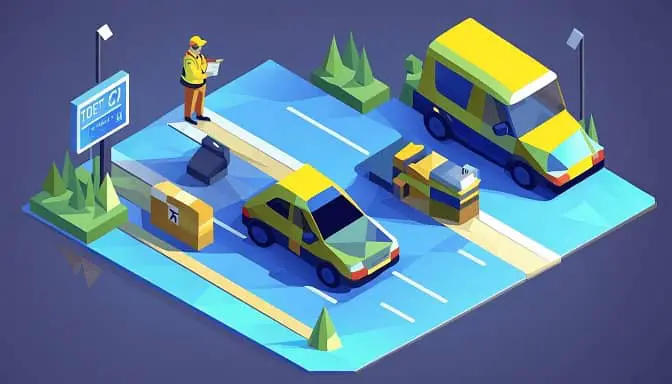
Table of Contents
Background on Number Coding Scheme
The number coding scheme is a strategy implemented by governments to control the number of vehicles on the road. It involves restricting certain vehicles from using the roads on specific days based on the last digit of their license plate. This system aims to reduce traffic congestion and improve air quality in highly congested areas.
For example, in the city of Manila, Philippines, the number coding scheme is implemented to address the growing traffic problem. Vehicles with license plates ending in 1 and 2 are not allowed to travel on Mondays, those ending in 3 and 4 on Tuesdays, and so on. This rotation system ensures that only a portion of vehicles are on the road on any given day, reducing traffic volume.
The number coding scheme is based on the assumption that limiting the number of vehicles on the road will alleviate congestion. However, it is important to consider the long-term consequences of this approach. While it may provide temporary relief, it is essentially a stop-gap measure that does not address the root causes of traffic congestion.
Moreover, the number coding scheme can have unintended consequences. In some countries, limiting the number of vehicles using this scheme has actually led to more traffic congestion. This is because people who can afford to buy another car tend to have more than one vehicle, resulting in an increase in the overall number of vehicles on the road.
In the next section, we will explore the long-term consequences of the number coding scheme and discuss why it may not be an effective solution in the long run.
Long-term Consequences of the Number Coding Scheme
The number coding scheme, although implemented with the intention of controlling the number of vehicles on the road, is essentially a stop-gap measure. While it may provide temporary relief from traffic congestion, it fails to address the root causes of the problem. In the long-term, the number coding scheme can have detrimental consequences that undermine its effectiveness.
One of the main reasons why the number coding scheme is considered a stop-gap measure is because it does not tackle the underlying issues contributing to traffic congestion. Instead of addressing factors such as inadequate road infrastructure, inefficient public transportation systems, and urban planning deficiencies, the scheme simply restricts the number of vehicles on the road on specific days based on their license plate numbers.
By focusing solely on limiting the number of vehicles, the number coding scheme fails to provide sustainable solutions to traffic congestion. It does not encourage the development of alternative transportation options or promote behavior changes that reduce the reliance on private vehicles. As a result, the scheme does not effectively address the long-term challenges associated with traffic congestion.
Furthermore, the number coding scheme can have unintended consequences that exacerbate traffic congestion instead of alleviating it. In some countries, the scheme has actually led to more traffic congestion due to the behavior of individuals who can afford to buy another car. These individuals tend to have more than one vehicle, and they purchase additional cars to circumvent the restrictions imposed by the scheme.
The purchase of additional vehicles by individuals to bypass the number coding scheme creates a counterproductive outcome. Instead of reducing the number of vehicles on the road, it increases the overall number of vehicles. This increase in the number of cars ultimately contributes to more traffic congestion, defeating the purpose of the scheme.
The unexpected results observed in countries where the number coding scheme has led to more traffic congestion highlight the importance of considering the long-term consequences of such policies. It is crucial to evaluate the potential perverse incentives that may arise from implementing measures like the number coding scheme.
To effectively address the issue of controlling the number of vehicles on the road, alternative approaches should be explored. These approaches should focus on promoting sustainable transportation options that reduce the overall demand for private vehicles. Improving public transportation systems, implementing carpooling initiatives, and encouraging the use of alternative modes of transportation like bicycles or electric scooters are some examples of sustainable solutions.
By shifting the focus towards sustainable transportation options, the number of vehicles on the road can be reduced without inadvertently encouraging behaviors that undermine the intended goals. It is essential to consider the long-term consequences and potential perverse incentives associated with any policy or action aimed at controlling the number of vehicles on the road.
Number Coding Scheme as a Perverse Incentive
A perverse incentive is a policy or action that unintentionally encourages behavior that is counterproductive or undesirable. In the context of economics, it refers to a situation where the intended outcome of a policy or action is not achieved, and instead, the opposite effect occurs. The number coding scheme can be seen as an example of a perverse incentive.
A perverse incentive is a policy or action that unintentionally encourages behavior that is counterproductive or undesirable.
Best Course of Action to Control the Number of Vehicles
To effectively control the number of vehicles on the road, it is crucial to explore contemporary and creative approaches that can limit the proliferation of cars.
Here are five potential strategies that can be implemented, each with its own justification:
1. Implement a Vehicle Quota System
Introducing a vehicle quota system would limit the number of new cars that can be registered each year. This approach has been successfully implemented in cities like Singapore, where individuals must bid for a Certificate of Entitlement (COE) to own a car.
By setting a limited number of COEs available each year, the government can control the number of new vehicles on the road. This system encourages individuals to carefully consider their need for a car and discourages unnecessary car ownership.
2. Expand and Improve Public Transportation
Investing in the expansion and improvement of public transportation systems is crucial to reducing the reliance on private vehicles. By providing reliable, efficient, and affordable public transportation options, individuals will be more inclined to use public transit instead of owning a car.
This approach not only reduces the number of vehicles on the road but also helps alleviate traffic congestion and reduce carbon emissions. Thus, governments must allocate enough financial resources for this purpose for the benefit of the citizens.
3. Encourage Carpooling and Ride-Sharing
Promoting carpooling and ride-sharing initiatives can significantly reduce the number of vehicles on the road. By incentivizing individuals to share rides, such as offering discounted toll fees or dedicated carpool lanes, more people will be encouraged to carpool or use ride-sharing services.
This approach maximizes the use of existing vehicles and reduces the need for additional cars on the road. It also inculcates the value of sharing and enhances socialization.
4. Develop and Promote Alternative Modes of Transportation
Investing in alternative modes of transportation, such as bicycles and electric scooters, can provide viable alternatives to private car ownership. By creating dedicated bike lanes, implementing bike-sharing programs, and offering incentives for electric scooter usage, individuals will have more sustainable transportation options.
This approach not only reduces the number of vehicles on the road but also promotes a healthier and more environmentally friendly lifestyle. A healthy citizenry reduces national costs on health care thereby makes available funds for other important public needs like education.
5. Implement Congestion Pricing
Congestion pricing is a system where drivers are charged a fee for entering certain congested areas during peak hours. By implementing congestion pricing, individuals are discouraged from driving during peak times, reducing traffic congestion and the overall number of vehicles on the road.
The revenue generated from congestion pricing can be reinvested in public transportation and infrastructure improvements. More infrastructure projects mean more job opportunities for everyone.
Each of these strategies offers a unique approach to controlling the number of vehicles on the road. By implementing a combination of these approaches, policymakers can effectively limit the proliferation of cars while promoting sustainable transportation options.
It is essential to consider the specific needs and characteristics of each city or region when determining the best course of action. By taking a creative and forward-thinking approach, we can create a more sustainable and efficient transportation system for the future.
Conclusion
To conclude, the number coding scheme is a complex issue that requires careful consideration. Throughout this article, we have explored the background of the number coding scheme and discussed its long-term consequences. We have also examined how the number coding scheme can act as a perverse incentive, leading to unintended consequences.
In order to effectively control the number of vehicles on the road, it is crucial to implement a combination of strategies. These strategies include implementing a vehicle quota system, expanding and improving public transportation, encouraging carpooling and ride-sharing, developing and promoting alternative modes of transportation, and implementing congestion pricing.
By implementing these strategies, policymakers can limit the proliferation of cars while promoting sustainable transportation options. It is important to consider the specific needs and characteristics of each city or region when determining the best course of action. By taking a creative and forward-thinking approach, we can create a more sustainable and efficient transportation system for the future.
Summing this all up, the number coding scheme is not a standalone solution to controlling the number of vehicles on the road. It requires a comprehensive and multifaceted approach that addresses the underlying issues of traffic congestion, pollution, and sustainability. By implementing a combination of strategies, we can work towards a more balanced and efficient transportation system that benefits both individuals and the environment without compromising urban development.
References
Dewan, K. K., & Ahmad, I. (2007). Carpooling: A step to reduce congestion. Engineering Letters, 14(1), 61-66.
Koh, W. T., & Lee, D. K. (1994). The vehicle quota system in Singapore: an assessment. Transportation Research Part A: Policy and Practice, 28(1), 31-47.
Lehe, L. (2019). Downtown congestion pricing in practice. Transportation Research Part C: Emerging Technologies, 100, 200-223.



